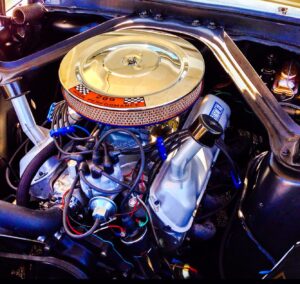Ford Mustang 1965: The unmatched icon of American Muscle
1. Ford Mustang 1965: The icon of American automotive engineering
6. Conclusion
Ford Mustang 1965: The icon of American automotive engineering
The 1965 Ford Mustang is often considered one of the most important and iconic cars in automotive history. This muscle car not only redefined the American automotive landscape but also launched an entire cultural revolution. It was designed to be affordable, stylish, and accessible, and its influence on the performance car market is still felt today.
The birth of the Mustang
Introduced to the public on April 17, 1964, at the New York World’s Fair, the 1965 Mustang was a bold statement by Ford. It was conceived as a new breed of car—a compact, sporty vehicle that combined style, performance, and practicality at a reasonable price. Unlike other muscle cars of the era, which were often expensive, the Mustang was designed to be affordable for a broad range of buyers, from young professionals to families looking for a car with personality and flair.
The car’s success came almost immediately, with Ford selling over 22,000 Mustangs on its first day. Within the first two years, more than 400,000 units were sold, solidifying its place in automotive history. It was an immediate success for Ford, and its impact on the American car market was profound. It effectively created the “pony car” segment, inspiring a generation of performance cars that combined affordable prices with sporty aesthetics.
Design and features
The 1965 Ford Mustang was built on the Ford Falcon platform but had a distinct design that set it apart from anything else on the road. The long, aggressive hood, short rear deck, and iconic galloping horse logo gave the Mustang a look that was both sleek and muscular. The original Mustang was available as a hardtop coupe, convertible, and later as a fastback, offering buyers a variety of options to suit their tastes.
Under the hood, the 1965 Mustang offered several engine options, starting with a 170 cubic-inch six-cylinder engine producing 105 horsepower. However, it was the V8 options that captured the hearts of enthusiasts, particularly the 289 cubic-inch V8, which produced up to 271 horsepower in its high-performance version. This engine gave the Mustang the kind of power that drivers craved, making it a true performance car. It was fast, stylish, and could hold its own against the best of the competition.
Inside, the 1965 Mustang featured a simple but elegant design, with bucket seats, an instrument panel that was both functional and stylish, and a driver-focused cockpit. This combination of a performance-oriented interior with an approachable price tag was a key factor in its success.
Cultural impact and legacy
The 1965 Mustang didn’t just change the automotive market—it helped shape the culture of the 1960s. As the country was immersed in the countercultural movements of the decade, the Mustang became a symbol of freedom and rebellion. With its affordable price and sporty nature, the Mustang was seen as a car for young people who wanted something that matched their sense of independence and adventure.
Its iconic status was solidified when it appeared in movies and television, most famously in the 1968 film Bullitt, starring Steve McQueen. The high-speed chase scene in a 1968 Mustang GT was not only a landmark moment in cinematic history but also helped cement the Mustang as a symbol of American muscle and style.
The Mustang’s cultural significance extends beyond the 1960s. Over the decades, the Mustang has remained a staple of American automotive culture, evolving with the times while staying true to the spirit of the original 1965 model. The car has continuously been updated, with various redesigns and performance enhancements, but the legacy of the first-generation Mustang is still evident in every modern iteration.
The Mustang today
The 1965 Mustang may have started it all, but the Ford Mustang continues to be a symbol of American automotive pride today. The 2024 Ford Mustang, while incorporating modern technology and performance upgrades, still carries the same rebellious spirit that was introduced in 1965. The car remains a fan favorite and is one of the best-selling sports cars in the world.
Whether in its classic 1965 form or modern versions, the Ford Mustang represents not only a piece of automotive history but also a continuing story of American innovation and performance.












